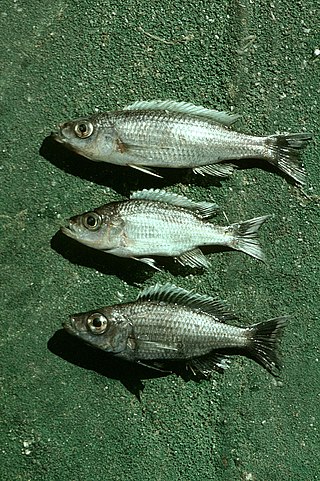
Herring are various species of forage fish, belonging to the order Clupeiformes.
Sinibrama of freshwater ray-finned fish belonging to the family Xenocyprididae, the East Asian minnows or sharpbellies. The fihses in this genus are found in southern China, Taiwan, Laos, and Vietnam. These are silvery fishes with deep, laterally compressed bodies, large eyes, and terminal mouths. They tend to grow no larger than 20 cm in standard length.
Ricola macrops is the only species of the monotypic genus Ricola, a genus of the family Loricariidae of catfish.

Callochromis macrops is a species cichlid endemic to Lake Tanganyika where it is found over sandy bottoms. This species reaches a length of 13.5 centimetres (5.3 in) TL. This species can also be found in the aquarium trade. It is the type species of the genus Callochromis.

Diplotaxodon macrops is a species of haplochromine cichlid which is endemic to Lake Malawi. It is found throughout the lake in Malawi, Mozambique, and Tanzania. Within Lake Malawi it is abundant near the lake bed over rock shelves. It appears to be a plankton eating species that feeds on insect larvae, crustaceans, and diatoms.
Synodontis macrops is a species of upside-down catfish endemic to Uganda where it is found in the Aswa River basin. This species grows to a length of 17.3 centimetres (6.8 in) TL.

An anchovy is a small, common forage fish of the family Engraulidae. Most species are found in marine waters, but several will enter brackish water, and some in South America are restricted to fresh water.
Sinibrama affinis is a species of ray-finned fish in the genus Sinibrama. It is found in southern China, northern Vietnam, and Laos. It inhabits rivers.
Sinibrama longianalis is a species of ray-finned fish in the genus Sinibrama. This species is endemic to Guizhou in China.
Sinibrama melrosei is a species of ray-finned fish in the genus Sinibrama. It is found in southern China, Vietnam, and Laos. It inhabits rivers.
Sinibrama wui is a species of ray-finned fish in the genus Sinibrama which is endemic to China. It is the type species of the genus Sinibrama but there is some controversy as to which form was described first. If the form described by S.Y Lin in 1932 is considered specifically distinct from that described by Rendahl then the form named by Rendahl should revert to the binomial Sinibrama typus.

Umpqua dace is a species of ray-finned fish in the genus Rhinichthys. It is endemic to the United States where it inhabits the Umpqua River drainage in Oregon.

Umatilla dace is a species of ray-finned fish in the genus Rhinichthys. It is found in the drainage basin of the Columbia River in British Columbia, Washington state, Oregon and Idaho.

The blackstripe barb is a species of cyprinid fish in the genus Enteromius which is widely distributed in West Africa where it is harvested for human consumption.

Myomyrus is a genus of elephantfish in the family Mormyridae. Its members reach about 25–30 cm (10–12 in) in length and are restricted to the Congo River Basin in Africa.
Atrilinea is a genus of freshwater ray-finned fishes belonging to the family Xenocyprididae. This is a small genus with three valid species, all of which are endemic to China.
The blackspot conger is an eel in the family Congridae. It was described by Albert Günther in 1870, originally under the genus Conger. It is a subtropical, marine eel which is known from the eastern Atlantic Ocean, including Madeira and Azores. It dwells at a depth range of 30–100 meters and burrows into sand. Males can reach a maximum total length of 50 centimetres.
Atrilinea macrops is a species of freshwater ray-finned fishes belonging to the family Xenocyprididae. This species has been recordedonly from Dayaoshan in Guangxi.
Ptychidio macrops, the bigeye ratmouthed barbel, is a species of cyprinid of the genus Ptychidio. It inhabits China, has a maximum length of 20.1 centimetres (7.9 in) and is considered harmless to humans.
Hypostomus macrops is a species of catfish in the family Loricariidae. It is native to South America, where it occurs in the Das Velhas River basin. The species reaches 28.8 cm SL and is believed to be a facultative air-breather.








